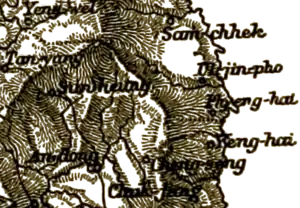Sunheung
Sunheung is a township administered as part of the municipality of Yeongju in North Gyeongsang, South Korea. The present local government administers an area of 54.35 square kilometers (20.98 sq mi).
| Sunheung Township | |||||||
|---|---|---|---|---|---|---|---|
 A detail from a 1904 map of Korea, showing "Sun-heung" as the largest town northwest of the provincial capital Andong | |||||||
| Korean name | |||||||
| Hangul | 순흥면 | ||||||
| Hanja | 順興面 | ||||||
| Literal meaning | The Township of Following Prosperity | ||||||
| |||||||
Located in Sunheung is Sosu Seowon, a Neo-Confucian Academy built in the 16th century and today a UNESCO World Heritage Site.
Name
Sunheung is an anglicization of the McCune–Reischauer romanization Sunhŭng. Its official romanization in South Korea is Sunheung. In 19th century sources, Sunheung appears as Sioun-heng-fu,[1] from a French transcription of the Korean placename and the Chinese pronunciation of its status as the seat of a district or commandery. Although the name literally means "Adhering to", "Obeying", or "Following Prosperity" or "Success", Sunheung is also Bon-gwan of a Korean clan in the area which included the influential Korean Confucianist An Hyang.
History
Under the late Joseon dynasty, Sunheung was a district capital overseeing the plains and hinterland around Mount Taebaek. Its mountains were the site of Korea's first foreign mining concern, a silver mine whose permit was revoked by the royal court in Seoul after a few months of operation in the early 1850s.[1][2]
References
Citations
- EB (1878), p. 391.
- Dallet (1874), p. iv.
Bibliography
- , Encyclopædia Britannica, 9th ed., Vol. VI, New York: Charles Scribner's Sons, 1878, pp. 390–394.
- Dallet, Charles (1874), "Introduction", Histoire de l'Église de Corée, Paris: Victor Palmé. (in French)
External links
- "Old Korea, Pt. I", a partial English translation of Dallet's History of the Korean Church at Lotus & Persimmon